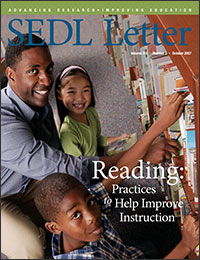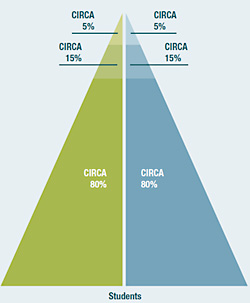Response to Intervention (RtI): A Systematic Approach to Reading and School Improvement
The No Child Left Behind Act (NCLB) and the Individuals with Disabilities Education Improvement Act (IDEA) have created the need for significant systemic changes at all levels of the education system (Handler, 2006). These federal laws are intended to hold schools accountable for improving student learning and enhance the academic performance of every child. Spurred by the demand for improved student achievement, schools and districts are now seeking meaningful, research-based reform strategies to improve instruction.

Much attention has recently focused on Response to Intervention (RtI), an alternative approach to diagnosing specific learning disabilities. RtI focuses schools and districts on prevention and early intervention for students with academic difficulties (McIntosh, Chard, Boland, & Horner, 2006; Gerston & Dimino, 2006). It is a multi-tier instructional approach used in the general education classroom to improve the academic performance of struggling learners before they are identified as learning disabled (National Association of State Directors of Special Education [NASDSE] & Council of Administrators of Special Education [CASE], May 2006). RtI provides a way to identify students with learning disabilities based on dynamic assessment. Gerston and Dimino (2006) explain that RtI “seems much more direct and logical than relying on discrepancies between IQ scores and reading achievement scores” (p. 100). In fact, they report that the U.S. Department of Education advocated in 2005 that the IQ-discrepancy criterion for identifying students as learning disabled be abandoned because this “wait to fail” approach doesn’t help close the achievement gap. Gersten and Dimino quote the U.S. Department of Education as reporting, “The IQ-discrepancy criterion is potentially harmful to students as it results in delaying intervention until a student’s achievement is sufficiently low so that discrepancy is achieved” (p. 101).
RtI is of special significance in the area of reading because most students identified as learning disabled are poor readers (Lyon, 1995; Gersten & Dimino, 2006; President’s Commission on Excellence in Special Education, 2002). RtI is generally used to address academic rather than behavioral problems, and the interventions usually target reading. According to Gersten and Dimino (2006), “RtI is integrally linked to the concept of providing intensive early intervention to prevent later reading failure” (p. 101).
The RtI process can also be viewed as an approach to school improvement. According to NASDSE (May 2006), “RtI is more than prereferral services; it is a comprehensive service delivery system that requires significant changes in how a school serves all students” (p. 2).
RtI Core Principles
Teach all children
RtI was developed on the belief that all children can learn and educators are responsible for identifying and fostering conditions that promote learning for all children.
Intervene early
It is best to intervene early when academic and behavior difficulties are relatively small.
Use multi-tier model
Employ a multi-tier model to effectively differentiate the nature and intensity of instruction to improve educational outcomes for all students.
Use problem-solving process
Use a clearly defined problem-solving process to identify individual needs and evaluate interventions that apply to all students in the system. The process should identify the problem and why it is happening, then identify interventions that will help rectify the problem, and finally monitor progress to determine if the interventions worked.
Use assessment
In RtI, three types of assessments are used—screening, diagnostics, and progress monitoring.
Screening provides low-cost, repeatable testing of age-appropriate critical academic or behavioral skills. It is a first step in identifying “red flags” and whether additional assessment is needed.
A diagnostic assessment is an in-depth assessment related to strengths and weaknesses in each skill area. It helps determine what students already know and can do and identify needed instruction.
Progress monitoring measures each student’s level of performance against identified goals for learning at regular intervals. Progress is measured by comparing expected and actual rates of learning. Instructional strategies are then adjusted to meet the individual student’s learning needs.
Use evidence-based instruction
Use instructional practices and interventions that have foundations in scientifically based research. Curriculum and instruction should have demonstrated effectiveness for the student’s situation and the school setting.
Monitor progress
Much of the assessment in RtI is progress monitoring and should be a form of dynamic assessment that measures change in students’ level or rate of learning (Fuchs & Fuchs, 2006a). Use assessment measures that are sensitive to growth and can be applied frequently to monitor student progress.
Use data
Central to RtI practice is the use of student data to make instructional decisions and to make classification and program placement decisions (e.g., moving students from the first tier to the second). This requires an ongoing data collection system.
Adapted from Batsche, G., Elliott, J., Graden, J. L., Grimes, J., Kovaleski, J. F., Prasse, D., Reschly, D. J., Schrag, J., & Tilly, W. D. (2006). Response to Intervention: Policy considerations and implementation (p. 22). Alexandria, VA: National Association of State Directors of Special Education, Inc.
What is Response to Intervention?
Response to Intervention (RtI) presents a well-integrated system of instruction and intervention designed for implementation across general and special education based on students’ academic performance and behavior data. RtI reflects the philosophy of the President’s Commission on Excellence in Special Education (2002) that “children placed in special education are general education children first.”
In the RtI process, 1) the school conducts a schoolwide screening of academic skills; 2) students receive research-based instruction or intervention that addresses their needs; 3) teachers measure and monitor students’ progress; and 4) teachers use data to make instructional decisions including eligibility for special education. Instructional decisions are made based on students’ responsiveness to the instruction or intervention.
Batsche et al. (2006) define RtI as the practice of providing high quality instruction and interventions matched to student need, monitoring progress frequently to make decisions about changes in instruction or goals and applying child response data to important educational decisions. (p. 3)
There are two approaches to intervention or instruction using the RtI model: a problem-solving approach and a standard treatment protocol. The problem-solving approach is data-based and involves installing a decision-making system that allows teachers to design and implement personalized instructional strategies for individual students to improve the student’s rate of learning based on data (Batsche et al., 2006). The problem-solving approach seems to be the favored approach of school districts. According to Fuchs and Fuchs (2006a), its popularity is related to the fact that for each child an effort is made to personalize assessment and intervention. They write, “This individualized approach is a potential weakness as well as a strength. The problem-solving approach pre-supposes considerable expertise among practitioners and in assessment and intervention” (p. 95). Fuchs and Fuchs note that in order for the problem-solving approach to be successfully implemented, practitioners should be skilled in various types of assessments and interventions; have the judgment and experience to know which assessments and interventions apply; and have the knowledge and opportunity to measure the effectiveness of the interventions.

Fuchs and Fuchs (2006a) describe the standard treatment protocol as an alternative to the problem-solving approach that is often favored by researchers. Using the standard treatment protocol means that students receive the same intervention for a fixed period of time, rather than individualized intervention unique to the learning needs of each child. Fuchs and Fuchs explain, “If students respond to the treatment trial, they are seen as remediated and disability free and are returned to the classroom for instruction. If they are unresponsive, they move to a more intensive Tier 2 standard treatment protocol” (p. 95). Then, if students show insufficient progress during the Tier 2 standard treatment protocol, “ a disability is suspected and further evaluation is warranted” (p. 95). Using the standard treatment protocol in tiered intervention can be advantageous in that teachers can be easily trained because there is one standard protocol to implement. It is also easier to check for fidelity of implementation because everyone knows what to implement (Batsche et al., 2006).
Both approaches have benefits and drawbacks. For example, the standard treatment protocol is likely to identify children who are “true positives” or truly have learning disabilities, but it is also more likely to identify children who are “false negatives.” These are children who at the higher tiers of RtI appear not to have learning disabilities, but who in reality could not survive in the regular classroom (Fuchs & Fuchs, 2006a). Batsche et al. (2006) suggest that a combination of the two approaches be used at Tier 2.
Essential Components and Implementation of RtI
There are three essential components to implementing RtI as outlined by Batsche et al. (2006): (1) multiple tiers of intervention, (2) a problem-solving method—not to be confused with the problem-solving approach to intervention or instruction previously discussed—and (3) an integrated data collection and assessment system. In order to address the essential RtI components, schools and districts will need to examine their systems and processes to identify existing logistical and infrastructure components that must be changed or modified to support RtI implementation.
Multiple Tiers of Intervention
The first component of RtI is multiple tiers of intervention that can be applied as schoolwide academic and behavior supports. Figure 1 illustrates a three-tier RtI framework. Other RtI frameworks have from two to four tiers of intervention (Fuchs & Fuchs, 2006a; Klingner & Edwards, 2006), but each involves screening, interventions, and progress monitoring. Regardless of which RtI framework is implemented, as students move through the tiers, the degree, intensity, duration, and sometimes types of intervention/instruction administered to the student increases.
Fuchs and Fuchs (2006b) discuss several points for consideration when building capacity for RtI at each tier. For example, schools and districts should consider the efficacy of the universal core program, the expected effect size for interventions, the proportion of students who respond adequately, and how to measure fidelity of implementation accurately. Regarding resources and infrastructure, it is similarly important for schools and districts to evaluate the feasibility and cost of implementing the universal core program, progress monitoring, and professional development for teachers. These factors should be considered for each subject area and age or grade level.
| Academic Systems Tier 3
Tier 2
Tier 1
| Figure 1:
| Behavioral Systems Tier 3
Tier 2
Tier 1
|
| Source: Batsche, G., Elliott, J., Graden, J. L., Grimes, J., Kovaleski, J. F., Prasse, D., Reschly, D. J., Schrag, J., and Tilly, W. D. (2006). Response to Intervention: Policy considerations and implementation (p. 22). Alexandria, VA: National Association of State Directors of Special Education, Inc. Reprinted with permission from NASDSE (www.nasdse.org). | ||
Tier 1
In Tier 1, also referred to as the “primary” layer of intervention, most students (about 80%) receive instruction based on state standards, the foundational core curriculum provided by the school or district. The curriculum should feature high-quality instruction that is differentiated to meet individual student needs. Schools and districts take a proactive and preventive approach to intervention in Tier 1.
Conduct universal screening. At the beginning of the school year, universal screening measures are usually administered to students in essential academic areas (e.g., reading and language arts) in order to identify students’ proficiency levels. Screening is a type of assessment that provides quick, low-cost, repeatable testing of age-appropriate critical academic or behavioral skills to identify struggling learners for further diagnostic testing and interventions (Johnson, Mellard, Fuchs, & McKnight, 2006). Examples of screening measures sometimes used by schools/districts are state assessments, benchmarks, or districtwide criterion- or norm-referenced tests administered to students. The screening data are organized and then analyzed by teacher teams to assess group and individual performance on specific skills.

Provide interventions. Based on this data analysis, goals are set and high-quality instruction or interventions are designed and implemented to bring large numbers of students to adequate levels of proficiency in specific skills (Batsche et al., 2006). High-quality intervention means that instruction is rooted in scientifically based research and incorporates proven methods that match student needs, as supported by IDEA and NCLB.
Monitor progress. Progress monitoring is the practice of frequently assessing students’ academic performance to determine whether students are benefiting from instruction. Progress monitoring may also be used to modify programs for struggling students and gauge the rate of student improvement (Johnson et al., 2006). In order to monitor progress, Deno (1985) suggests that curriculum-based measures sensitive to growth in student performance over a relatively short time period be used. Teachers should obtain achievement data frequently in order to acquire sufficient progress monitoring data that can be graphed. (For more information on progress monitoring, please refer to the National Center on Student Progress Monitoring, www.studentprogress.org.)
NCLB Definition of Scientifically Based Research
- Involves the application of rigorous, systematic, and objective procedures to obtain reliable and valid knowledge relevant to education activities and programs
- Employs systematic, empirical methods that draw on observation or experiment
- Involves rigorous data analysis
- Relies on measurements or observational methods that provide reliable and valid data
- Is evaluated using experimental or quasi-experimental designs
- Ensures that experimental studies have sufficient detail and clarity to allow for replication
- Has been accepted by a peer-reviewed journal or approved by a panel of independent experts
Source: Part A–Sec. 9101. Definitions, #37.
Students demonstrating inadequate or poor response to instruction in Tier 1 based on progress monitoring data are identified and subsequently moved to Tier 2 for more targeted instructional assistance.
Tier 2
Instruction in Tier 2 (about 15% of the student population), also referred to as the “secondary” layer of intervention, is characterized by targeted short-term intervention in addition to core instruction (Batsche et al., 2006). Tier 2 instruction does not supplant instruction of the core curriculum; rather, it supplements it. This supplemental instruction can be developed through a standard treatment protocol, a problem-solving approach to instruction, or a combination of both. A standard treatment protocol provides structured or scripted interventions in a systematic manner in small groups. However, the problem-solving approach allows instructional support teams to plan personalized interventions to address an individual student’s needs. Based on progress monitoring data, students who achieve adequate progress in Tier 2 are reintegrated into Tier 1. Those students who continue to respond poorly to intervention, along with those still needing substantial instructional supports that are not available in the general classroom, are moved to Tier 3 for more intensive instruction.
Tier 3
Instruction in Tier 3, also known as the “tertiary” layer of instruction, is the most intense level of instruction provided to students in general education. It can be provided in the general classroom, and should be, according to NASDSE (2006, May). The organization explains in “Myths about Response to Intervention (RtI) Implementation”:
If Tier 3 is defined exclusively as special education, it is possible that additional intensive instructional programs would be set up OUTSIDE of the triangle model, which defeats the purpose of having the model for delivering services to all students. (p. 1)
Fuchs & Fuchs (2006b) take a slightly different view. They note:
In many but not all systems, tertiary intervention is conducted under the auspices of special education, given the student’s need for individualized rather than standard programming and given the expense and expertise required for individualized programming. In this regard, we note that RtI as a multitier prevention system, is designed to prevent long-term academic and social failure, not designed to prevent special education, per se. Special education, we believe, should be conceptualized as a valuable resource within the prevention system, with students entering and exiting as their progress warrants. (p. 621)

Instruction in Tier 3 is individualized, of longer duration, and administered in substantial blocks of time for the approximately 5% of students who continue to respond poorly to interventions in Tier 2 (Bradley, Danielson, & Doolittle, 2007; Batsche et al., 2006).
Diagnostic assessments can be given to individual students in this level to determine strengths and weakness in levels of performance. Based on past history, a multidisciplinary team can be formed to determine if the student has a disability that requires specialized instruction, which can be provided under IDEA. Further evaluation may be warranted, and the team may also review data gathered during Tier 1 and Tier 2 for special education eligibility.
Problem-Solving Method
The second component to RtI is the problem-solving method or process, which consists of four steps: (1) defining the problem, (2) analyzing the cause, (3) developing and implementing an intervention plan, and (4) evaluating the effectiveness of intervention (see Figure 2). Again, this method is not to be confused with the problem-solving approach to designing instruction or intervention.
Batsche et al. (2006) explain, “The effectiveness of instruction at each tier must be determined through its implementation. As such, we must put in place a decision-making system that will help design of instructional strategies with a high probability of success, as well as provide for the frequent monitoring of instructional effectiveness” (p. 25-26).
| Figure 1: | ||
|
Evaluate Did our plan work?
| Define the problem Is there a problem? What is it?
|
Analyze Why is it happening? |
| Source: Batsche, G., Elliott, J., Graden, J. L., Grimes, J., Kovaleski, J. F., Prasse, D., Reschly, D. J., Schrag, J., & Tilly, W.D. (2006). Response to Intervention: Policy considerations and implementation (p. 22). Alexandria, VA: National Association of State Directors of Special Education, Inc. Reprinted with permission from NASDSE (www.nasdse.org). For a more complete explanation of how problem solving is used at each of the RtI tiers, see pages 47–50 of this NASDSE report. | ||
Integrated Data Collection System
Not surprisingly, an integrated data collection or assessment system is required to implement RtI effectively and make good decisions at each tier (Batsche et al., 2006). Togneri (2003) suggests that schools should use multiple measures of student performance because data plays a critical role in instructional decision making. Student progress data drives instruction or intervention in the RtI approach. It is imperative that schools integrate their data collection and assessment systems in a manner that is useful, relevant, and easily accessible for teacher use. Furthermore, assessment procedures differ at each tier.
For example, it has been recommended that proactive assessment procedures be used periodically throughout the year as universal screening at Tier 1. These assessments will have two functions: (1) to help design instruction so all students reach a certain level of proficiency, and (2) to determine which students will need more intensive instruction at Tier 2 (Batsche et al., 2006).
At Tier 2 the assessments must determine whether intensive remedial efforts result in the desired improvement. Then at Tier 3, the assessments must reliably distinguish which students are performing well below their peers, lacking the targeted skills. The Tier 3 assessments should also determine each student’s rate of progress. Batsche et al. (2006) report that if the assessment at the first two tiers is thorough, it is likely that the third tier might include a summary of data collected previously.
Batsche et al. (2006) also recommend an evaluation of staff members in providing scientifically based, effective interventions at Tiers 1 and 2. They emphasize that “without sufficient treatment fidelity, determination of a student’s RtI cannot be validly assessed” (p. 26). By establishing the essential components of an intervention and evaluating staff, it can be determined that an intervention was implemented as intended. Of course the concerns with treatment fidelity also highlight the need for providing quality in-service professional development (for example, professional development that meets the National Staff Development Council standards) that improves teacher knowledge and skill, both paramount to successful and reliable implementation of RtI.
Additional resources related to RtI
Secondary schools interested in a schoolwide implementation of RtI may refer to the following links to Web sites of states that are currently implementing RtI statewide across all grade levels. We have also posted a list of other helpful online resources related to RtI.
Relevant RtI Web Resources
This is a listing of relevant Web sites retrieved on June 1, 2007, from the Regional Resource and Federal Center Network at http://www.rrfcnetwork.org. This list includes Web links from various organizations such as comprehensive centers, content centers, regional resources centers, and universities.
State RtI Web Resources
This is a listing of States web resources retrieved on June 1, 2007 from the Regional Resource and Federal Center Network at http://www.rrfcnetwork.org. Many schools and districts are already using a type of problem solving or

Challenges to RtI Implementation
Some of the challenges to implementing RtI are 1) limited progress monitoring tools for secondary students; 2) funding issues; 3) redefining the roles of educators; 4) clarifying parental involvement; 5) integrating culturally relevant instructional strategies; and 6) scaling up RtI implementation.
Not much attention has been focused on implementing RtI in secondary schools (Duffy, 2007). One of the biggest challenges in secondary schools is the limited number of progress monitoring tools in various content areas. This shortage is exacerbated by the departmental structure of high schools, which makes a systemwide implementation of RtI difficult.
Funding issues could prove challenging for schools interested in connecting RtI implementation to other initiatives such as Reading First, dropout prevention, special education identification, and positive behavior intervention supports. The RtI framework is consistent with or aligned with the framework used by Reading First (Gersten & Dimino, 2006) and positive behavior support (Batsche et al., 2006). If done successfully, the pooling of funds from these various initiatives could prove to be a good allocation of resources to ensure that struggling learners’ needs are met in the most cost-effective way.
Another challenging area that requires attention is redefining the roles of classroom teachers and other educational service providers, including speech and language pathologists; physical and occupational therapists; school psychologists; diagnosticians; and paraprofessionals.
In November 2006, NASDSE collaborated with numerous national educational organizations to publish a document titled New Roles in Response to Intervention: Creating Success for Schools and Children. This document discussed the unique roles of various education professionals and their responsibilities in the RtI approach.
Despite the challenges of RtI, many see it is as a viable approach for systemic school improvement.
Clarifying parental roles and involvement in the RtI approach and improving communication of progress monitoring data are emerging issues for schools implementing RtI. Implementing strategies that involve parents in their children’s education has positive effects on students’ academic achievement and also strengthens school-family partnerships (Coleman, Starzynski, Winnick, Palmer, & Furr, 2006). To ensure parental participation in the RtI process, Johnson et al. (2006) recommend that schools and districts make parents feel welcome and comfortable in the school setting. They also suggest that parents remain involved in all phases of the RtI process and that schools inform parents of their children’s progress both orally and in writing. They emphasize that staff should communicate frequently and consistently with parents, especially parents of students responding inadequately to intervention who could be referred for special education services. The use of culturally relevant instructional practices for the benefit of students from culturally and linguistically diverse backgrounds is a concern (Klingner & Edwards, 2006). Schools and districts should be cautious in selecting evidence-based interventions to ensure that adopted interventions work with culturally and linguistically diverse students.
RtI In the Field: Georgetown ISD
Stephanie Blanck, director of special education for Georgetown Independent School District (GISD), says, “Response to Intervention is a process, not an event.” Blanck should know—she has been preparing for the use of RtI throughout the district for several years. She explains, “RtI builds on the campus support team process. It’s just one of many avenues a child may be recommended for.”
Georgetown is located about 30 miles north of Austin, Texas. GISD has a student population of more than 9,000. Last year the district piloted RtI at two elementary schools. This year, all nine of the district’s elementary schools will be using the process.
According to Blanck, district staff spent 2 years with focus groups learning about RtI and attending trainings, workshops, and conferences. GISD has adopted universal screening three times a year for all K–5 students. Students in grades 1–5 are screened in reading and math. The district is using a commercially available product for screening that has Spanish components.
Blanck says that in the past students were referred to special education primarily based on anecdotal information. There was not a universal screening process, nor extensive data collection.
and also strengthens school-family partnerships (Coleman, Starzynski, Winnick, Palmer, & Furr, 2006). To ensure parental participation in the RtI process, Johnson et al. (2006) recommend that schools and districts make parents feel welcome and comfortable in the school setting. They also suggest that parents remain involved in all phases of the RtI process and that schools inform parents of their children’s progress both orally and in writing. They emphasize that staff should communicate frequently and consistently with parents, especially parents of students responding inadequately to intervention who could be referred for special education services. The use of culturally relevant instructional practices for the benefit of students from culturally and linguistically diverse backgrounds is a concern (Klingner & Edwards, 2006). Schools and districts should be cautious in selecting evidence-based interventions to ensure that adopted interventions work with culturally and linguistically diverse students.
Finally, large-scale implementation of RtI across all academic content areas and grade levels is very challenging for schools and districts (Bradley et “Now students are given targeted or intensive instruction at the time of need, there is a process for structured data collection, and decisions are made based on that data,” she reports. “The big advantage is that students are receiving high-quality, intense, research-proven instruction immediately as the need is identified.”
In the past, students may have needed instruction beyond that in the general classroom, but if he or she did not qualify for special education, they would not receive the additional instruction. “Now,” Blanck explains, “even if a child does not ultimately qualify for special education but still needs targeted instruction, he or she will get it.”
Georgetown staff will be working on increasing the number and variety of Tier 3 interventions this year. The district tries to match student intervention to student need. “Not all students have the same deficits, so we must really peel that onion down to the core to determine what is keeping that student from being successful. Staff are being guided in this analytical process until they can fully embrace it themselves,” Blanck says.
Finally, large-scale implementation of RtI across all academic content areas and grade levels is very challenging for schools and districts (Bradley et al., 2007). RtI is still an emerging approach, with some elements identified only in the past decade. Consequently, it will take some time for professionals to acquire an understanding of the core principles that guide the practice as well as the components that define it (Batsche et al., 2006). Schools and districts have limited knowledge and experience with scaling up RtI implementation—a situation that is expected to improve with time.
Despite the challenges of implementing RtI, many see it as a viable approach for systemic school improvement. Others see its promise in the field of reading as a sensible path to strengthen instruction and meet student needs early on, thus avoiding the misidentification of students as learning disabled and improving achievement for at-risk students. As Fuchs and Fuchs (2006a) recently wrote, “Right now, we most clearly see its promise in regards to how its multilayered structure can be implemented in the early grades to strengthen the intensity and effectiveness of reading instruction for at-risk students, preventing chronic school failure that corrodes children’s spirit and diminishes all of us who work on behalf of public schools” (p. 98).
References
- Batsche, G., Elliott, J., Graden, J. L., Grimes, J., Kovaleski, J. F., Prasse, D., Schrag, J., & Tilly, W.D. (2006). Response to intervention: Policy considerations and implementation. Alexandria, VA: National Association of State Directors of Special Education, Inc.
- Bradley, R., Danielson, L., & Doolittle, J. (2007, May/ June). Responsiveness to intervention: 1997–2007. Council for Exceptional Children, 39(5), 8–13.
- Coleman, A. L., Starzynski, A. L., Winnick, S. Y., Palmer, S. R., & Furr, J. E. (2006, September). It takes a parent: Transforming education in the wake of the No Child Left Behind Act. Washington, DC: Appleseed.
- Deno, S. L. (1985). Curriculum-based measurement: The emerging alternative. Exceptional Children, 52(3), 219–232.
- Duffy, H. (2007). Meeting the needs of significantly struggling learners in high school: A look at approaches to tiered intervention. Washington, DC: National High School Center at American Institutes for Research. Retrieved August 30, 2007, from http://www.betterhighschools.org
- Fuchs, D., & Fuchs, L. S. (2006a). Introduction to response to intervention: What, why, and how valid is it? Reading Research Quarterly, 41(1), 93–99.
- Fuchs, L. S., & Fuchs, D. (2006b). A framework for building capacity for responsiveness to intervention. School Psychology Review, 35(4), 621–626.
- Gersten, R., & Dimino, J. (2006). RTI (Response to Intervention): Rethinking special education for students with reading difficulties (yet again). Reading Research Quarterly, 41(1), 99–108.
- Handler, B. R. (2006, September/October). Two acts, one goal: Meeting the shared vision of No Child Left Behind and Individuals with Disabilities Education Improvement Act of 2004. The Clearing House, 80(1).
- Johnson, E., Mellard, D. F., Fuchs, D., & McKnight, M. A. (2006). Responsiveness to intervention (RtI): How to do It. National Research Center on Learning Disabilities (NRCLD). Lawrence, KS: University of Kansas.
- Klingner, J. K., & Edwards, P. A. (2006). Cultural considerations with response to intervention models. Reading Research Quarterly, 41(1), 108–115.
- Lyon, G. R. (1995). Research initiatives in learning disabilities: Contributions from scientists supported by the National Institute of Child Health and Human Development. Journal of Child Neurology, 10 (suppl. 1), S120–S126.
- McIntosh, K., Chard, D. J., Boland, J. B., & Horner, R. H. (2006). Demonstration of combined efforts in school-wide academic and behavioral systems and incidence of reading and behavior challenges in early elementary grades. Journal of Positive Behavior Interventions, 8(3).
- National Association of State Directors of Special Education & Council of Administrators of Special Education. (2006, May). Response to intervention: A joint paper by NASDSE and CASE. Retrieved June 1, 2007, from http://www.nasdse.org
- National Association of State Directors of Special Education. (2006, May). Myths about response to intervention (RtI). Retrieved June 1, 2007, from http://www.nasdse.org
- National Staff Development Council. (2001). Standards for staff development (Revised). Oxford, OH: NSDC.
- Togneri, W. (March 2003). Beyond islands of excellence: What districts can do to improve instruction and achievement in all schools— a leadership brief. Baltimore, MD: Learning First Alliance, Association for Supervision and Curriculum Development.
- President’s Commission on Excellence in Special Education. (2002). A new era: Revitalizing special education for children and their families. Washington, DC: U.S. Department of Education. Retrieved August 28, 2007, from http://www.ed.gov/inits/commissionsboards/ whspecialeducation/reports.html
- U. S. Department of Education. (2003). No Child Left Behind. Retrieved June 12, 2007, from http://www. ed.gov/policy/elsec/leg/esea02/pg107.html
Next Article: SEDL Receives AT&T Excelerator Grant



